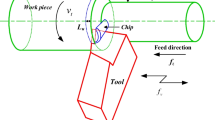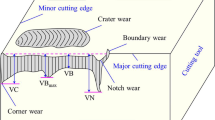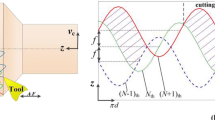Abstract
Due to the tool-workpiece separation effect, high-speed ultrasonic vibration cutting has the proven ability to reduce tool flank wear and prolong tool life by up to approximately three times when turning Ti-6Al-4V alloys in the recent research. Temperature reduction caused by the cooling medium penetrating into the gaps of the tool-workpiece contact zone is considered to be the primary reason for this remarkable performance. In this paper, a tool-workpiece thermocouple system was developed for the temperature measurement of high-speed ultrasonic vibration cutting Ti-6Al-4V alloys. First, the calibration of the tool-workpiece thermocouple was conducted to identify the piecewise linear relation between thermoelectric power and cutting temperature. Next, the insulation of the thermoelectric circuit from both the vibration-stimulated circuit and the experiment platform was realized. Finally, comparative cutting experiments on high-speed ultrasonic vibration cutting and conventional cutting with and without cutting fluid were carried out. The experimental results demonstrate that in the dry cutting experiments, no obvious temperature difference between these two methods occurred. However, when cutting fluid was applied, compared to conventional cutting, a maximum 30% temperature reduction could be realized by high-speed ultrasonic vibration cutting with a duty cycle value of 0.55 at cutting speeds of 250 to 300 m/min. Therefore, cutting fluid is thought to be an essential part of effective cooling in the process of high-speed ultrasonic vibration cutting and its cooling behavior during such a short separation interval needs further researches.
Similar content being viewed by others
Change history
02 April 2018
The original version of this article contained a mistake. Figure7 in the original article is incorrect.
References
Amin AKMN, Ismail AF, Khairusshima MKN (2007) Effectiveness of uncoated WC-Co and PCD inserts in end milling of titanium alloy—Ti-6Al-4V. Int J Mater Process Technol 192-193:147–158. https://doi.org/10.1016/j.jmatprotec.2007.04.095
Ezugwu EO, Wang ZM (1997) Titanium alloy and their machinability—a review. Int J Mater Process Technol 68(3):262–274. https://doi.org/10.1016/S0924-0136(96)00030-1
Schulz H, Moriwaki T (1992) High-speed machining. CIRP Ann Manuf Technol 41(2):637–643. https://doi.org/10.1016/S0007-8506(07)63250-8
Zoya ZA, Krishnamurthy R (2000) The performance of CBN tools in the machining of titanium alloys. Int J Mater Process Technol 100(1–3):80–86. https://doi.org/10.1016/S0924-0136(99)00464-1
Corduan N, Himbart T, Poulachon C, Dessoly M, Lambertin M, Vigneau J, Payoux B (2003) Wear mechanisms of new tool materials for Ti-6Al-4V high performance machining. CIRP Ann Manuf Technol 52(1):73–76. https://doi.org/10.1016/S0007-8506(07)60534-4.
Silva RBD, Machado AR, Ezugwu EO, Bonney J, Sales WF (2013) Tool life and wear mechanisms in high speed machining of Ti-6Al-4V alloy with PCD tools under various coolant pressures. Int J Mater Process Technol 213(8):1459–1464. https://doi.org/10.1016/j.jmatprotec.2013.03.008
Venugopal KA, Paul S, Chattopadhyay AB (2007) Growth of tool wear in turning of Ti-6Al-4V alloy under cryogenic cooling. Wear 262:1071–1078. https://doi.org/10.1016/j.wear.2006.11.010.
Sui H, Zhang X, Zhang D, Jiang X, Wu R (2017) Feasibility study of high-speed ultrasonic vibration cutting titanium alloy. J Mater Process Technol 247:111–120. https://doi.org/10.1016/j.jmatprotec.2017.03.017
Jiang X, Zhang X, Zhu X, Sui H, Zhang D (2018) Study of phase shift control in high-speed ultrasonic vibration cutting. IEEE T Ind Electron 65(3):2467–2474. https://doi.org/10.1109/TIE.2017.2740827
Abukhshim NA, Mativenga PT, Sheikh MA (2006) Heat generation and temperature prediction in metal cutting: a review and implications for high speed machining. Int J Mach Tools Manuf 46(7-8):782–800. https://doi.org/10.1016/j.ijmachtools.2005.07.024
Santos MC, Araújo Filho JS, Barrozo MAS, Jackson MJ, Machado AR (2017) Development and application of a temperature measurement device using the tool-workpiece thermocouple method in turning at high cutting speeds. Int J Adv Manuf Technol 89(5-8):2287–2298. https://doi.org/10.1007/s00170-016-9281-1
Yang Y, Zhu W (2014) Study on cutting temperature during milling of titanium alloy based on FEM and experiment. Int J Adv Manuf Technol 73(9-12):1511–1521. https://doi.org/10.1007/s00170-014-5937-x
Le Coz G, Jrad M, Laheurte P, Dudzinski D (2017) Analysis of local cutting edge geometry on temperature distribution and surface integrity when dry drilling of aeronautical alloys. Int J Adv Manuf Technol 93:2037–2044. https://doi.org/10.1007/s00170-017-0671-9
Khajehzadeh M, Razfar MR (2016) Theoretical modeling of tool mean temperature during ultrasonically assisted turning. Proc Inst Mech Eng B J Eng Manuf 230(4):675–693. https://doi.org/10.1177/0954405414556333
Le Coz G, Dudzinski D (2014) Temperature variation in the workpiece and in the cutting tool when dry milling Inconel 718. Int J Adv Manuf Technol 74(5-8):1133–1139. https://doi.org/10.1007/s00170-014-6006-1
Song W, Wang Z, Deng J, Zhou K, Wang S, Guo Z (2017) Cutting temperature analysis and experiment of Ti–MoS2/Zr-coated cemented carbide tool. Int J Adv Manuf Technol 93:799–809. https://doi.org/10.1007/s00170-017-0509-5
Müller B, Renz U (2003) Time resolved temperature measurements in manufacturing. Measurement 34(4):363–370. https://doi.org/10.1016/j.measurement.2003.08.009
Zhang J, Liu Z, Du J (2017) Prediction of cutting temperature distributions on rake face of coated cutting tools. Int J Adv Manuf Technol 91(1-4):49–57. https://doi.org/10.1007/s00170-016-9719-5
Acknowledgments
This work was supported by the National Natural Science Foundation of China (grant numbers 51290292, 51475029, and 51475031); the Application Research and Development Plan of Heilongjiang Province of China (grant number GA12A402); and the Fundamental Research Funds for the Central Universities.
Author information
Authors and Affiliations
Corresponding author
Rights and permissions
About this article
Cite this article
Zhang, X., Lu, Z., Peng, Z. et al. Development of a tool-workpiece thermocouple system for comparative study of the cutting temperature when high-speed ultrasonic vibration cutting Ti-6Al-4V alloys with and without cutting fluids. Int J Adv Manuf Technol 96, 237–246 (2018). https://doi.org/10.1007/s00170-018-1600-2
Received:
Accepted:
Published:
Issue Date:
DOI: https://doi.org/10.1007/s00170-018-1600-2




